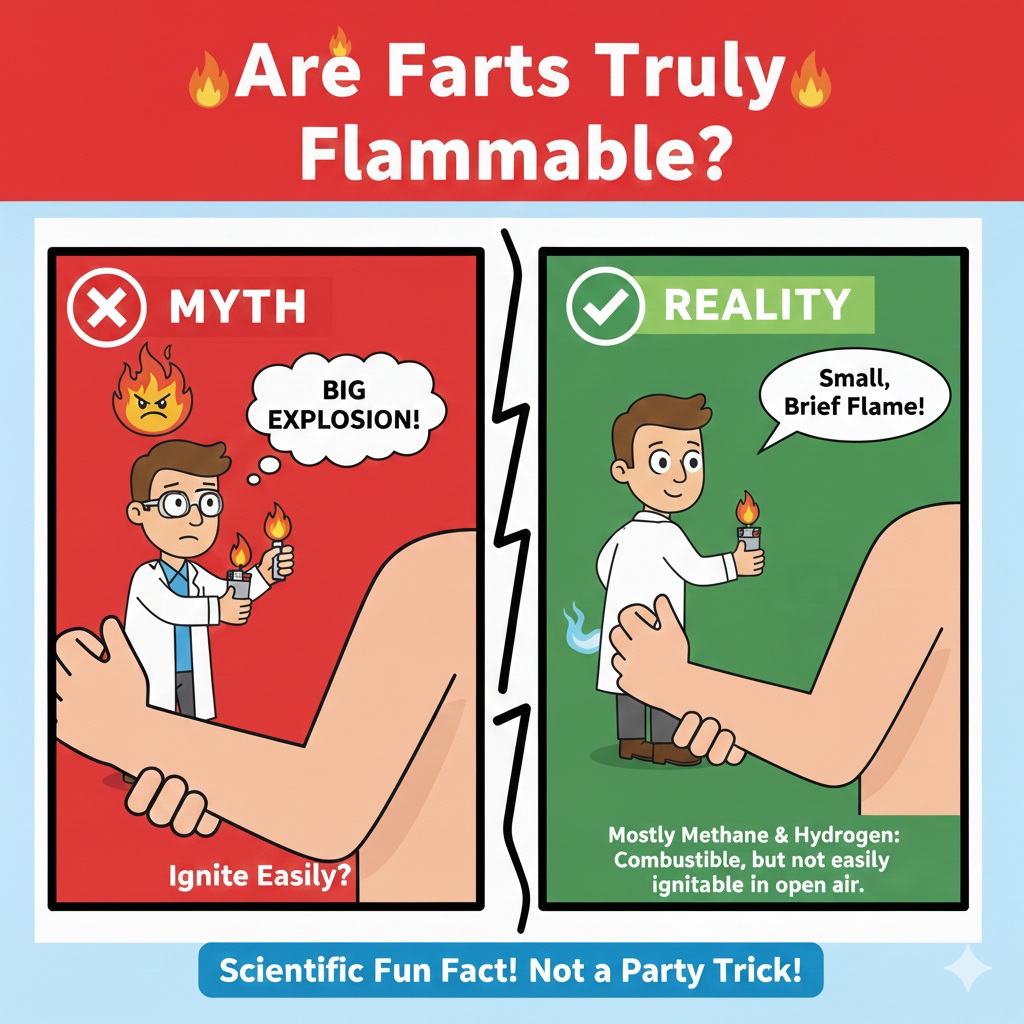
Have you ever wondered if farts are actually flammable? Well, I did too, and I delved into the science behind this intriguing question. In this article, I’ll uncover the truth about whether our gas-passing antics could potentially light up a room.
We’ve all heard the jokes and rumors about the flammability of farts, but is there any truth to it? Join me on this investigative journey as we explore the composition of flatulence and whether it contains the necessary elements to ignite a fiery spectacle. Let’s separate fact from fiction and get to the bottom of this gassy mystery.
Key Takeaways
- Methane is the key component in farts that makes them flammable, as it can ignite when mixed with oxygen in the air.
- Factors such as methane content, oxygen levels, ignition source, methane concentration, and speed of release influence the flammability of farts.
- All flatulence contains flammable gases like methane and hydrogen, but caution is advised when testing the flammability of farts.
- The concentration of methane in typical farts is usually too low to catch fire, as it needs to be around 5% to be flammable, which is often not reached.
The Science of Farts
When it comes to understanding the flammability of farts, it’s essential to delve into the science behind these natural emissions. Flatulence is primarily composed of odorless gases like nitrogen, carbon dioxide, oxygen, and methane.
Methane is the key player in the flammability of farts. It’s highly combustible and is the same gas that makes natural gas so effective as a fuel source.
The flammable nature of farts occurs when methane produced in the intestines is released and mixes with oxygen in the air. This combination creates a potential for ignition if a spark or flame is introduced.
Flammability Factors
When it comes to the flammability of farts, there are several key factors at play that determine whether a fart can ignite or not. Understanding these factors can shed light on the science behind this unique bodily function:
- Methane Content: As mentioned earlier, methane is a crucial component in the flammability of farts. The higher the methane content in a fart, the more likely it is to be flammable.
- Oxygen Levels: The presence of oxygen is also essential for a fart to be flammable. When the methane released mixes with oxygen in the air, it creates the necessary conditions for combustion.
- Ignition Source: While methane and oxygen are necessary, an ignition source such as a spark or flame is what actually triggers the combustion of a fart. Without an ignition source, even a methane-rich fart may not catch fire.
- Concentration: The concentration of methane in a fart plays a significant role in its flammability. Farts with higher methane concentrations are more likely to ignite compared to those with lower concentrations.
- Speed of Release: The speed at which a fart is released can also impact its flammability. A faster release may result in better mixing of methane and oxygen, increasing the chances of combustion.
The flammability of farts is influenced by a combination of factors including methane content, oxygen levels, presence of an ignition source, concentration of methane, and speed of release. Understanding these factors can provide insights into the intriguing science behind the combustible nature of flatulence.
Mythbusting Rumors
Rumors surrounding the flammability of farts have spread far and wide, leading to a mix of myths and misconceptions. Let’s debunk some of the most common ones:
Myth 1: Only some farts are flammable.
- Fact: While certain factors can influence the flammability of farts, all flatulence contains flammable gases like methane and hydrogen.
- Fact: While caution is always advisable when dealing with fire, many have safely demonstrated the flammability of farts in controlled environments.
- Fact: While farts can ignite under the right conditions, the quantity of gas released is typically not enough to cause an explosion.
By clarifying these misconceptions, we can better understand the science behind the flammability of farts.
Ignition Potential
When it comes to the Ignition Potential of flatulence, it’s important to understand the conditions required for a fart to catch fire. Methane, a key component of flatus, is indeed flammable and can ignite under certain circumstances. However, for a fart to be flammable, it needs to be sufficiently concentrated, requiring a higher proportion of methane in the gas mixture released.
While methane on its own is highly flammable, the concentration of methane in typical flatus is often too low to ignite. This means that in most cases, the average fart is not going to be flammable enough to catch fire. Controlled experiments have shown that the Ignition Potential of a fart can be influenced by various factors, such as diet, gut microbiome composition, and individual differences in gas production.
To further illustrate this point, consider that the lower flammability limit of methane in air is around 5%, meaning that the concentration of methane in a gas mixture must be at least this high for it to be flammable. In typical flatus, the methane content is usually below this threshold, which explains why the majority of farts do not result in fiery outcomes.
Conclusion
Based on the Ignition Potential of flatulence explored in this article, it’s clear that while methane in farts is flammable, the likelihood of a fart catching fire is minimal. Factors such as diet, gut microbiome composition, and individual gas production play significant roles in determining a fart’s flammability.
The concentration of methane in a typical fart is usually below the threshold required for ignition, making most farts non-flammable. Controlled experiments have shed light on the complexities surrounding the flammability of farts. Despite the humorous curiosity surrounding this topic, the science behind the flammability of farts reveals a fascinating interplay of biological and chemical factors.
Frequently Asked Questions
Can farts really catch fire?
Yes, farts can potentially catch fire due to the presence of methane, which is flammable. However, the concentration of methane in a typical fart is usually too low to ignite.
What factors influence a fart’s flammability?
Factors like diet, gut microbiome composition, and individual gas production differences can influence a fart’s flammability.
What is the lower flammability limit of methane in air?
The lower flammability limit of methane in air is around 5%, indicating that the methane concentration in flatulence is typically below this threshold.
How do controlled experiments contribute to understanding fart flammability?
Controlled experiments help highlight the complexities influencing the Ignition Potential of farts and provide scientific insights into this humorous but intriguing phenomenon.
